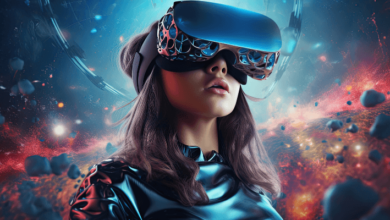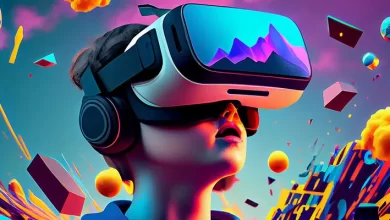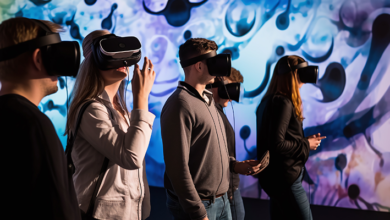AR & VR and Case Research Shaping Model Experiences

Augmented actuality (AR) and digital actuality (VR) are two dynamic applied sciences which have gathered the eye of entrepreneurs within the quickly altering subject of digital advertising, redefining the way in which manufacturers talk with their audiences. By enabling a fluid dance between the digital and the bodily, these applied sciences are doing extra than simply altering the foundations of the sport. Come alongside on a journey to find the magic that occurs when digital advertising, AR, and VR mix.
Why AR and VR is The Way forward for Advertising and marketing?
Think about this; once you flick thru your most well-liked social media platform, an augmented actuality filter seems, immediately remodeling your face right into a comical character. That is solely a small instance of how Augmented Actuality is erasing limits between the digital and the true world. By bringing interactive digital parts to real-world experiences, AR improves them past VR, which transmits folks to utterly digital content material.
For entrepreneurs, AR is a dynamic device that turns passive content material consumption into a fascinating interplay. Whether or not it’s the playful filters on social media, an interactive product packaging expertise, or a charming in-store journey, AR invitations shoppers to actively take part within the model story.
Conversely, VR takes customers to a world that’s past the bodily. With VR, customers may lose themselves in tales and turn out to be extra than simply viewers—they turn out to be an important a part of the narrative. Think about coming into a digital showroom, utilizing a simulated atmosphere to guage merchandise, and even taking a digital tour to distant areas. The key to VR’s energy is its capability to create robust emotions, that are the idea of buyer loyalty.
The mix of AR and VR is the place the true journey begins. Collectively, these applied sciences construct an ecosystem that allows manufacturers to offer seamless, complete experiences. Think about the next: an augmented actuality app permits customers to scan a product to unlock a digital actuality expertise that takes them into the model’s narrative or takes them on a digital tour of the product’s growth. This mix will increase the impression in initiatives involving digital advertising. Manufacturers might have interaction viewers throughout a number of channels and depart an enhanced and lasting impression by including AR elements to conventional commercials or utilizing VR to increase the narrative.
E-commerce has discovered a very candy spot for AR. Think about a world during which shoppers can nearly strive on clothes or see furnishings organized of their residing rooms earlier than clicking the “buy” button. By eliminating doubts and rising buyer confidence, AR turns on-line shopping for into an immersive expertise. Digital entrepreneurs can profit from a personalized and fascinating buyer expertise by integrating AR into e-commerce platforms. The choice to “strive before you purchase” advantages each prospects and types by rising buyer happiness and lowering return charges.
Creating experiences that individuals will keep in mind is the basic purpose of the partnership between AR, VR, and digital advertising. It’s about going past conventional advertising whereas creating consumer-lasting moments. A deeper impact is produced by the real looking VR expertise and the interactive side of AR, which finally results in elevated model loyalty.
AR and VR: Numbers in Focus
After briefly speaking about AR and VR, and earlier than shifting on to the case research we, as Multiplayer Company, have examined on this topic, let’s give attention to some statistics offered by Statista which have occurred lately and are anticipated sooner or later.
The marketplace for digital actuality (VR) and augmented actuality (AR) is predicted to achieve US$32.1B in income in 2023, indicating vital development prospects. It’s projected that this development will proceed at a exceptional annual price of 12.60%, with a market quantity forecast to achieve US$58.1B by 2028. AR Software program is the market chief on this business, with an estimated value of US$11.9B in 2023. By way of income technology, the US leads the pack with a projected $8,568.0M market quantity in 2023. By 2028, the AR and VR markets are projected to have 6,887M world customers, reflecting how broadly these applied sciences are getting used.

Supply
The AR and VR market has skilled vital development on a worldwide scale, with the US and China main the usual for innovation and widespread adoption.
Once we have a look at the overall map, we will see how AR VR expertise has gained momentum and that what it’s now’s only the start of the following brief interval. Once we have a look at promoting, the place our work is supported and targeted on with case research, we are going to see a leap on this subject sooner or later, similar to the overall figures.

Supply
By 2023, the worldwide AR promoting market is predicted to generate an astounding US$4.4B in income. It’s rising rapidly. Between 2023 and 2028, the market is predicted to develop at a compound yearly development price of 11%, placing it on observe to achieve US$7.5 billion. The US is main the way in which, with a major US$1,054M market quantity forecasted in 2023. Globally, AR promoting is increasing quickly, and the USA and China are additionally main the way in which in creating inventive, immersive campaigns. With the rising use of AR by entrepreneurs for in-app promoting, the market is increasing quickly and altering how shoppers work together with digital content material.
4 Examples of How Manufacturers Are Redefining Buyer Experiences with AR and VR
Case Research 1: New York Occasions VR Marketing campaign
The New York Occasions efficiently addressed the problem of attracting Gen Z readers by embracing Digital Actuality (VR) by way of the NYT VR platform. The initiative concerned distributing Google Cardboard viewers to 1.1 million print subscribers and launching a collection of VR brief movies, with the primary movie, “The Displaced,” specializing in the lives of refugee youngsters. The app recorded over half 1,000,000 downloads, distributed 1.3 million Google Cardboard units, and garnered 1.5 million views, with a powerful common engagement time of 6 minutes per session. The marketing campaign earned acclaim, successful the cell Grand Prix at Cannes Lions 2016 for its skill to evoke empathy and pleasure, showcasing the ability of VR in journalism and storytelling.

Supply
Case Research 2: Pizza Hut’s AR Marketing campaign with PAC-MAN

Supply
To mix nostalgia with progressive expertise, Pizza Hut launched a charming augmented actuality (AR) marketing campaign that includes the enduring online game PAC-MAN. Recognizing the necessity to innovate in a aggressive market dominated by on-line supply companies, Pizza Hut turned to AR to not solely have interaction prospects but additionally faucet into the fond recollections related to its dine-in expertise.
The marketing campaign centered round a limited-edition PAC-MAN pizza field, outfitted with a QR code that, when scanned with a smartphone, remodeled the field right into a playable PAC-MAN sport. This not solely added an interactive factor to the pizza expertise but additionally created a bridge between the previous and the current, interesting to shoppers’ sense of nostalgia.
The initiative concerned collaboration with PAC-MAN maker Bandai Namco Leisure, including an genuine contact to the marketing campaign. Yutaka Fuse, the pinnacle of licensing and branding at Bandai Namco Leisure, highlighted the synergy, stating that “PAC-MAN’s design and creation was impressed by the form of a pizza with a slice taken out of it.” This alignment made the partnership not solely progressive but additionally culturally related.
The outcomes had been spectacular, with the AR sport recording over 1.5 million views and a mean engagement time of 6 minutes per session. Furthermore, the marketing campaign prolonged past the digital realm, as Pizza Hut distributed 1.3 million PAC-MAN branded Google Cardboard units to its print subscribers.
As Pizza Hut continued its “Newstalgia” marketing campaign, promising to revive different favorites from its previous, helped prospects’ love for Pizza Hut whereas establishing new connections with youthful generations. This case examine stands as a testomony to the effectiveness of leveraging AR expertise to attach with shoppers, improve model picture, and drive enterprise success.
The achievement of the marketing campaign is excellent: 11,260 hours performed, 741 million media impression, 10.6 million Pac-Man bins bought,
Remarkably, for the month of March, the Pizza Hut field technically surpassed the mixed gross sales of the Nintendo Swap, Ps 5, and Xbox Sequence X, making it the best-selling sport console globally.
Case Research 3: The Augmented Actuality and Digital Actuality Sport Changer: FIFA World Cup Qatar 2022
The FIFA World Cup Qatar 2022 proved to be a historic occasion not just for the mesmerizing matches on the sector but additionally for the groundbreaking integration of Augmented Actuality (AR) and Digital Actuality (VR) applied sciences by sponsor manufacturers.
Sponsor manufacturers seized the chance to revolutionize fan engagement by way of AR and VR experiences. The immersive applied sciences provided followers a brand new strategy to work together with the event, turning residing rooms into 3D knowledge facilities and enabling customers to give attention to particular gamers or groups. Augmented Actuality enhanced protection allowed followers to expertise statistics in real-time, making a extra enriched and personalised viewing expertise.

Supply
Large sponsors, together with Adidas, Coca-Cola, Hyundai Motors, Qatar Power, Wanda Group, Chevrolet, Hublot, Peacock and Qatar Airways, embraced AR to market their merchandise. The mixing of AR filters, particularly on social media platforms like Snapchat and Instagram, turned a pattern. Manufacturers created partaking filters focusing on the youthful viewers, enabling customers to attach with the model in an immersive approach.

Supply
AR expertise prolonged past the digital realm into stadiums, facilitating simple navigation for spectators. Google glasses and AR had been utilized to assist followers discover their seats, uncover key areas inside the stadium, and improve the general buyer journey. The interactive expertise not solely entertained followers but additionally saved them engaged all through the event.
Manufacturers strategically utilized AR to boost the purchasing expertise for followers. Vogue manufacturers, particularly, leveraged AR expertise to permit followers to visualise the jerseys and sneakers of their favourite gamers in 3D. This immersive expertise personalised companies primarily based on particular person pursuits and favourite groups, resulting in elevated gross sales and model loyalty.

Supply
The success of AR and VR integration was evident within the large digital engagement figures. The FIFA World Cup Qatar 2022 witnessed virtually 6 billion engagements on social media, with a cumulative attain of 262 billion throughout all platforms. Manufacturers successfully tapped into the fervour of soccer followers, providing them novel and interactive experiences past conventional advertising strategies.
The FIFA World Cup Qatar 2022 marked a turning level in sports activities advertising with the widespread adoption of AR and VR applied sciences by sponsor manufacturers. The success tales of manufacturers leveraging AR filters, enhancing the client journey, and executing partaking campaigns reveal the immense potential of those applied sciences in capturing the eye and loyalty of followers. Because the world eagerly anticipates future sporting occasions, the Qatar 2022 case examine stands as a testomony to the transformative energy of AR and VR in redefining the fan expertise on a worldwide scale.
Case Research 4: Crimson Bull-Ninja “Win with Ninja!” Marketing campaign
Well-known gamer Tyler “Ninja” Blevins is the star of an progressive web-based AR marketing campaign that Crimson Bull has launched to step up its advertising sport. The Ninja AR Lens is an immersive expertise that distinguishes itself from different apps by not requiring app downloads. Customers might entry it with any smartphone by simply hitting a button on the Crimson Bull web site. A part of the “Win with Ninja” effort, the marketing campaign was first launched in Germany and invitations followers to ask Ninja into their houses, take footage with him, and enter a lottery to win the chance to play video games with him at Lollapalooza in Chicago.

Supply
The marketing campaign gives followers an interactive avatar of Ninja seamlessly built-in into their environment. This user-friendly, immediately accessible AR expertise aligns with Crimson Bull’s broader targets of accelerating model engagement and enhancing its digital presence. Ninja was some of the adopted players on Twitch, recognized for his record-breaking streams in fashionable video games like Halo, PUBG, Apex Legends, and Fortnite.
The marketing campaign’s success is obvious within the excessive engagement it has achieved. Ninja’s video in regards to the collaboration has acquired over 5 million views and 189,000 likes, whereas Crimson Bull’s video has been seen greater than 200,000 occasions. This displays the resonance of the AR initiative and its skill to seize the eye of Ninja’s devoted fan base.
Crimson Bull’s strategic transfer in combining AR expertise with the recognition of a gaming icon like Ninja demonstrates an progressive technique in digital advertising, creating memorable experiences and driving model loyalty. This marketing campaign is proof of how the advertising business is altering and the way firms are utilizing augmented actuality to shut the hole between digital and in-person encounters. Along with adapting to present customers’ preferences, Crimson Bull’s use of Net-AR demonstrates how AR could also be used to extend consumer participation, engagement, and model consciousness.
Conclusion
The mixing of AR, VR, and digital advertising is revolutionizing the way in which manufacturers join with their audiences. As we now have seen within the case research introduced above, these applied sciences have the ability to create partaking experiences that seize consideration, construct loyalty, and drive gross sales.
As AR and VR proceed to evolve, we will count on to see much more progressive and efficient advertising campaigns seem.
Learn the complete article right here







